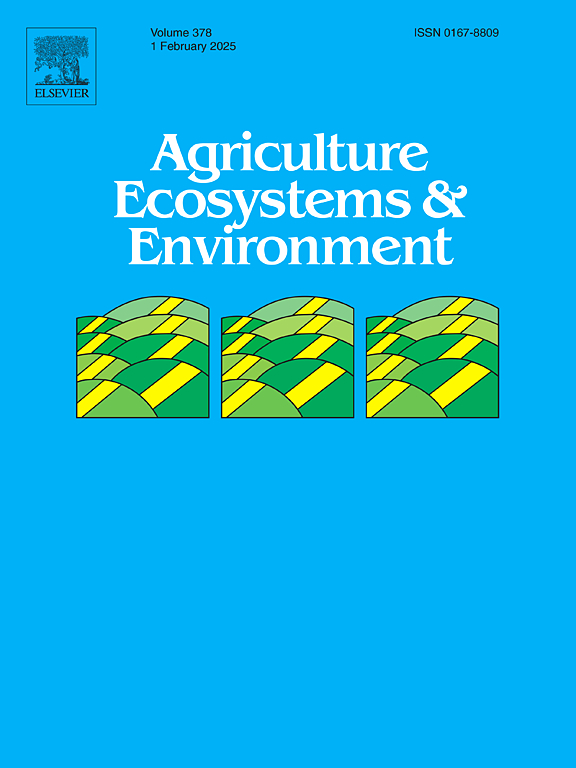西藏山地草原生态功能对草食动物长期排斥的不同响应
IF 6
1区 农林科学
Q1 AGRICULTURE, MULTIDISCIPLINARY
引用次数: 0
摘要
排除草食动物是青藏高原退化草原恢复和管理的一种普遍做法。然而,排除草食动物对山地草原生态系统结构和功能的长期影响的实验证据仍然很大程度上缺乏。本文研究了不同海拔梯度下四种典型草地类型(高寒草甸、高寒草甸、高寒草原和沼泽草甸)的长期食草动物排斥对生态功能的影响。结果表明:长期排除草食动物对山地草原生态系统功能的影响存在差异,沼泽草甸和高寒草原的EMF呈下降趋势,高寒草甸和高寒草甸的EMF呈上升趋势;排除草食动物有降低地上生态系统多功能性(AEMF)的趋势,而增加地下生态系统多功能性(BEMF)的趋势。结构方程模型通径分析表明,排除草食动物主要通过改变植物生产力和土壤养分调节EMF和BEMF,而影响AEMF主要通过影响植物多样性。这些结果表明,长期排除草食动物对多种生态功能的影响很大程度上取决于植物多样性、生产力和土壤养分,山地草原的生态系统多功能性大多呈下降趋势。研究结果还强调了制定适当的放牧管理措施对保护青藏高原广泛分布的山地草原生态系统的多功能性的根本重要性。本文章由计算机程序翻译,如有差异,请以英文原文为准。
Divergent responses of ecological functions to long-term herbivore exclusion in the Tibetan mountainous grasslands
Herbivore exclusion is a widespread practice used to restore and manage degraded grasslands on the Tibetan Plateau. However, experimental evidence for the long-term impacts of herbivore exclusion on ecosystem structure and functioning of mountainous grasslands is still largely lacking. Here, we examined long-term herbivore exclusion impacts on ecological functions across four typical grassland types (alpine screes, alpine meadow, alpine steppe, and swamp meadow) along an elevation gradient on the southern slope of Nyaiqentanglha Mountain. The results showed that long-term herbivore exclusion had divergent influences on ecosystem functioning of mountainous grasslands, with the EMF tended to decrease in swamp meadow and alpine steppe but increase in alpine meadow and alpine screes. In addition, herbivore exclusion tended to decrease the aboveground ecosystem multifunctionality (AEMF) but had a trend to increase the belowground ecosystem multifunctionality (BEMF). Path analysis of the structural equation model showed that herbivore exclusion regulated EMF and BEMF mainly through altering plant productivity and soil nutrients while influenced the AEMF primary by affecting plant diversity. These findings revealed that the impacts of long-term herbivore exclusion on multiple ecological functions greatly depended on plant diversity, productivity, and soil nutrients, with the mountainous grasslands mostly experiencing decrease trends on ecosystem multifunctionality. The findings also highlighted the fundamental importance of developing proper grazing management practice for protecting ecosystem multifunctionality in the widespread mountainous grasslands on the Tibetan Plateau.
求助全文
通过发布文献求助,成功后即可免费获取论文全文。
去求助
来源期刊

Agriculture, Ecosystems & Environment
环境科学-环境科学
CiteScore
11.70
自引率
9.10%
发文量
392
审稿时长
26 days
期刊介绍:
Agriculture, Ecosystems and Environment publishes scientific articles dealing with the interface between agroecosystems and the natural environment, specifically how agriculture influences the environment and how changes in that environment impact agroecosystems. Preference is given to papers from experimental and observational research at the field, system or landscape level, from studies that enhance our understanding of processes using data-based biophysical modelling, and papers that bridge scientific disciplines and integrate knowledge. All papers should be placed in an international or wide comparative context.
 求助内容:
求助内容: 应助结果提醒方式:
应助结果提醒方式:


